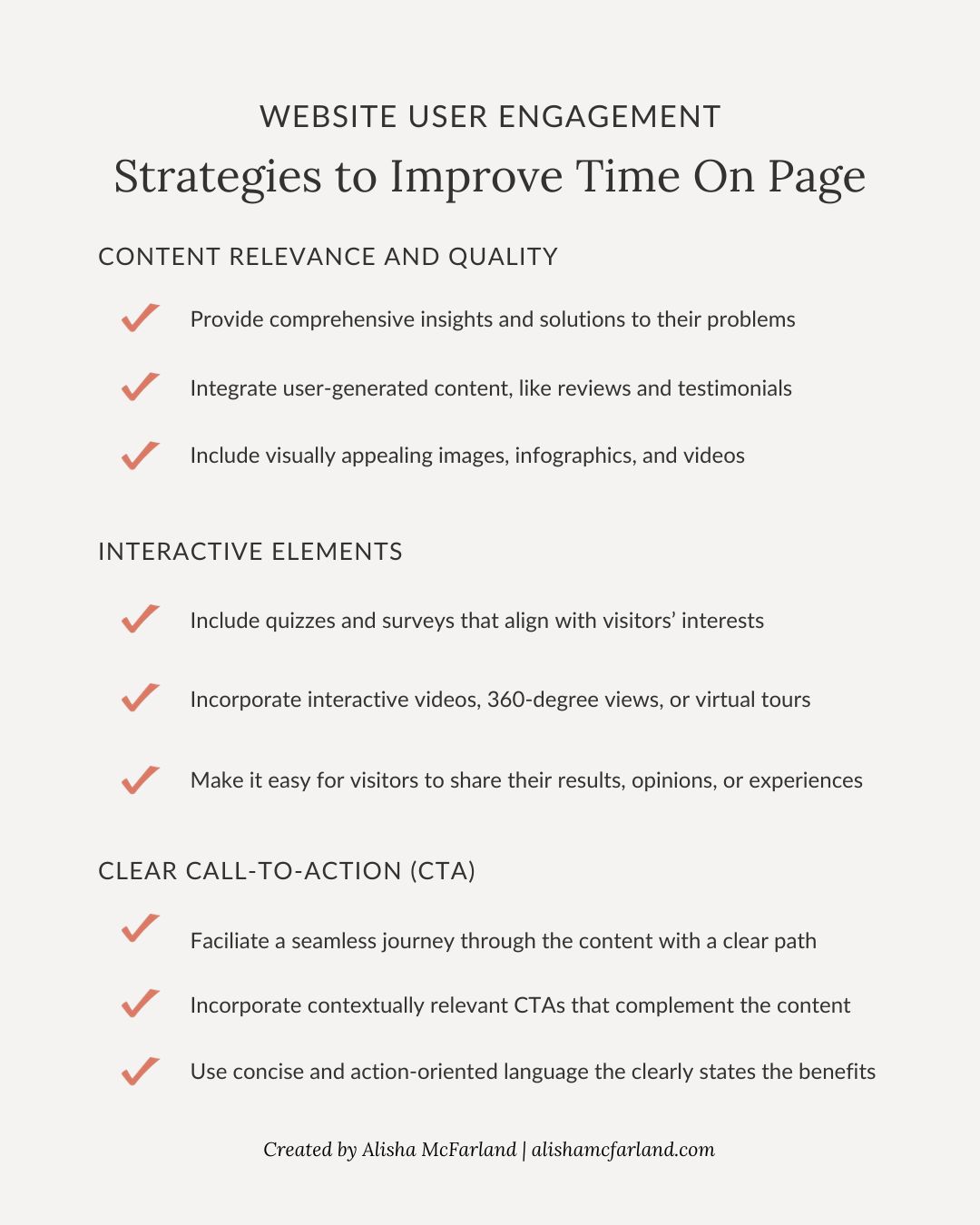While numerous metrics aid in gauging user behavior, ‘Time On Page’ emerges as an important indicator of user engagement and website performance. As businesses continue to strive for enhanced user experiences and increased conversions, comprehending the nuances of Time On Page data becomes even more important. This article looks into Time On Page, highlighting its significance, interpretation, and strategies to optimize user engagement.
Understanding Time On Page
Time On Page represents the duration a user spends on a specific webpage before navigating to another one or exiting the site. This metric holds pivotal importance in assessing user engagement, as it provides insights into the extent of users’ interest in the content provided.
A longer Time On Page generally implies that the content is compelling, relevant, and valuable to the user. Conversely, a short Time On Page might indicate that the content fails to meet users’ expectations, leading to a higher bounce rate.
Time On Page Targets
Acceptable time on page times vary based on several factors, including industry, content types, and the purpose of the website. But here are some averages to use as a gauge:
Ecommerce Websites
1 to 2 minutes
Informational Websites
2 to 3 minutes
Landing Pages
30 seconds to 1 minute
Interpreting Time On Page Data
Interpreting Time On Page data requires a nuanced understanding of user behavior and the context in which the data is collected. Here are some steps to help you effectively interpret Time On Page data:
Comparative Analysis
Compare Time On Page data across different pages and sections of the website. Identify patterns and discrepancies to understand which types of content are resonating with users and which ones are leading to early exits.
Segmentation of Audience
Segment the audience based on various parameters such as demographics, devices used, or traffic sources. Analyzing Time On Page data for different audience segments can provide insights into how specific groups interact with the content and help tailor strategies accordingly.
Bounce Rate Correlation
Analyze the correlation between Time On Page and Bounce Rate. A high bounce rate coupled with a short Time On Page might indicate that the content fails to meet user expectations. Conversely, a low bounce rate with a long Time On Page suggests that users find the content engaging and valuable.
Content Relevance
Evaluate the relevance of the content to the users’ search intent. A longer Time On Page could indicate that the content is fulfilling users’ needs, while a short Time On Page might suggest that the content is not aligned with what users are looking for.
Strategies to Improve User Engagement Using Time On Page Data
Utilizing time on page data effectively can lead to significant improvements in user engagement and overall website performance. Implementing the following strategies can help businesses optimize their websites and enhance user engagement:
Content Relevance and Quality
Creating high-quality, engaging content that aligns with users’ interests is a foundational strategy for sustaining longer Time On Page durations. Website visitors have increasingly discerning tastes and are quick to disengage if the content fails to captivate their attention. By offering valuable, informative, and relevant content, businesses can establish a meaningful connection with their audience, encouraging them to stay longer to consume the information.
High-quality content not only addresses users’ queries but also goes beyond surface-level information, providing comprehensive insights and solutions to their problems. By presenting well-researched and credible information, businesses can build trust and credibility, fostering a sense of authority and expertise within their respective industries. Such content not only keeps users engaged but also encourages them to explore additional pages, leading to longer Time On Page durations and decreased bounce rates.
Understanding users’ interests and preferences is crucial for tailoring content that resonates with their specific needs. Conducting market research, analyzing user feedback, and monitoring industry trends can provide valuable insights into the topics and formats that appeal most to a target audience. Integrating user-generated content, such as reviews, testimonials, or case studies, can also enhance engagement by offering authentic and relatable experiences that resonate with potential customers.
Incorporating visually appealing elements such as images, infographics, and videos can significantly enhance the overall appeal of the content, making it more compelling and accessible to users. Engaging multimedia not only helps in breaking the monotony of textual information but also facilitates better comprehension and retention of the presented content.
By consistently delivering high-quality, engaging content that aligns with users’ interests, businesses can establish a loyal and dedicated audience, fostering longer Time On Page durations, increased user satisfaction, and a greater likelihood of conversion and retention. This approach not only contributes to improved user engagement but also reinforces the brand’s credibility and authority in the digital sphere, fostering sustainable growth and success in the competitive online market.
Interactive Elements
Integrating interactive elements into a website can be a highly effective strategy for increasing Time On Page durations and fostering greater user engagement. By incorporating various interactive features, businesses can create a more immersive and dynamic user experience, encouraging visitors to spend more time exploring and interacting with the content. Interactive elements such as quizzes, surveys, polls, calculators, and interactive infographics not only captivate users’ attention but also stimulate their curiosity and participation, leading to prolonged engagement and reduced bounce rates.
Quizzes and surveys, for instance, enable users to actively participate in the content consumption process, providing an opportunity for self-assessment, personalization, and immediate feedback. These elements not only pique users’ interest but also encourage them to invest more time on the page, answering questions and exploring different facets of the presented content. By tailoring quizzes and surveys to align with users’ preferences and interests, businesses can create a more personalized and engaging experience, enhancing user satisfaction and encouraging return visits.
Furthermore, incorporating interactive videos, 360-degree product views, or virtual tours can offer users an immersive and visually engaging experience, enabling them to explore products, services, or destinations in a more comprehensive and interactive manner. Such immersive experiences foster a deeper connection with the content, compelling users to spend more time exploring the various features and details presented, thereby increasing Time On Page durations and fostering a stronger brand-consumer relationship.
Additionally, integrating interactive elements that encourage social sharing and user-generated content can contribute to extended Time On Page durations. By allowing users to share their results, opinions, or experiences on social media platforms, businesses can tap into the power of social engagement and virality, expanding their reach and fostering a community around their brand. This not only extends the reach of the content but also encourages users to revisit the page to view and engage with the shared content, contributing to longer Time On Page durations and increased brand exposure.
By strategically integrating interactive elements that cater to users’ preferences and foster active participation, businesses can create a more dynamic and engaging user experience, leading to longer Time On Page durations, increased user interaction, and a higher likelihood of conversion and retention. This approach not only enhances user engagement but also strengthens the brand’s relationship with its audience, fostering long-term loyalty and sustainable growth.
Clear Call-to-Action (CTA)
Implementing clear and compelling Call-to-Action (CTA) strategies can significantly contribute to longer Time On Page durations and increased user engagement. By strategically placing CTAs throughout the content, businesses can guide users toward desired actions, encouraging them to explore additional offerings, products, or services, thereby extending their stay on the webpage.
A well-crafted and visible CTA serves as a navigational signpost, prompting users to take the next step, whether it involves subscribing to a newsletter, downloading a resource, making a purchase, or exploring related content. By presenting CTAs that align with users’ interests and intentions, businesses can facilitate a seamless user journey, enabling users to delve deeper into the website’s offerings and providing them with a clear path to explore further, consequently leading to increased Time On Page durations.
Moreover, incorporating contextually relevant CTAs that complement the presented content can encourage users to engage with the website’s offerings without interrupting their browsing experience. By seamlessly integrating CTAs within the content flow and ensuring that they provide additional value or benefits to the users, businesses can cultivate a more intuitive and user-friendly experience, encouraging users to prolong their engagement and explore relevant sections of the website.
Leveraging persuasive language and incorporating visually appealing design elements can enhance the effectiveness of CTAs, capturing users’ attention and compelling them to take action. By using concise and action-oriented language that communicates the benefits of the proposed action, businesses can instill a sense of urgency and importance, encouraging users to invest more time in understanding the value proposition and benefits associated with the CTA.
By strategically incorporating clear and compelling CTAs that resonate with users’ needs and preferences, businesses can effectively guide users through the content journey, encouraging prolonged engagement, and increasing the likelihood of conversion and retention. This approach not only facilitates a seamless user experience but also reinforces the brand’s value proposition, fostering stronger connections and sustainable growth.
Take Away

Time On Page stands as a fundamental metric for evaluating user engagement and website performance. Its role in understanding user behavior, refining content strategies, and improving SEO performance underscores its significance. By implementing effective strategies and considering the nuances of Time On Page data, businesses can foster meaningful interactions with users, drive conversions, and establish a strong online presence.



